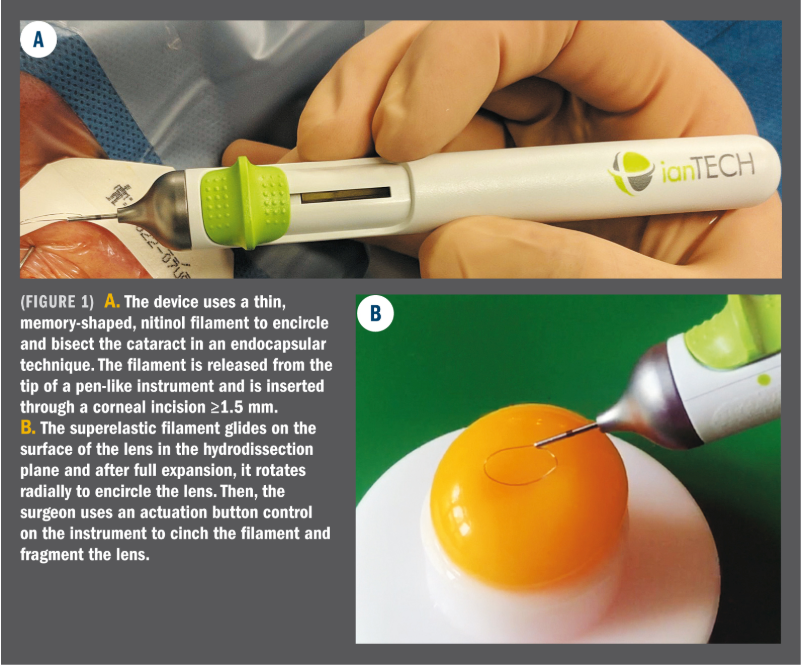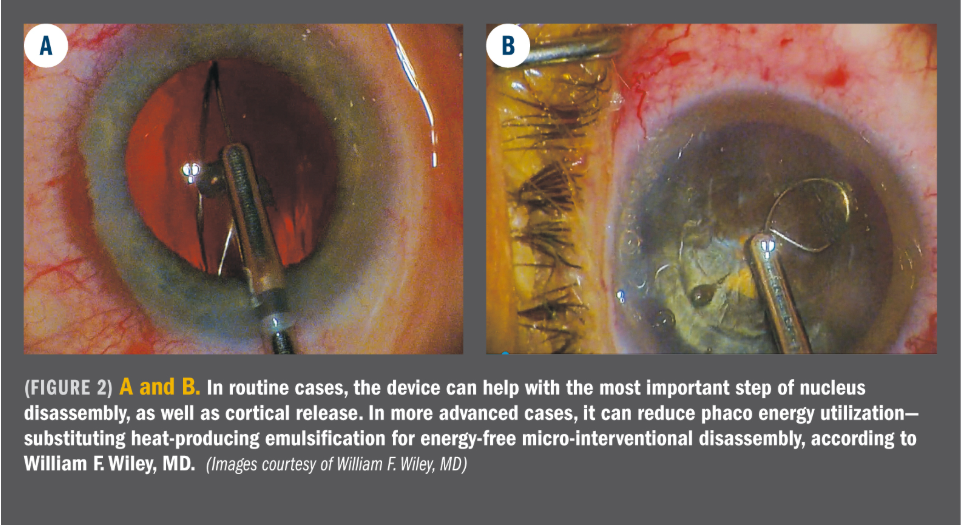Article
Lens fragmentation device is in the loop
Author(s):
A micro-interventional device that uses a nitinol filament can dissect any grade cataract without causing capsular stress.



A micro-interventional device that uses a nitinol filament can dissect any grade cataract without causing capsular stress.
Reviewed by William F. Wiley, MD
Mechanical micro-interventional lens fragmentation using a proprietary device (miLoop, Iantech) has the potential to improve phacoemulsification efficiency, control, and safety in all cataract surgery, and particularly for the challenging cases that involve very dense nuclei, said William F. Wiley, MD.
“Cataract surgeons are always looking to become more efficient in the operating room, and over the years, a lot of new hardware has been introduced to reduce the ultrasound energy requirement and complications,” said Dr. Wiley, medical director, Cleveland Eye Clinic, Cleveland, OH. “Yet, I sometimes wonder if these tools really made us better or more efficient surgeons.”
Micro-interventional lens fragmentation with the device is an elegant and energy-free technique for endocapsular lens fragmentation, Dr. Wiley noted.
“In routine cases, it can help with the most important step of nucleus disassembly as well as cortical release,” he said. “In more advanced cases, it can reduce phaco energy utilization-substituting heat-producing emulsification for energy-free micro-interventional disassembly.”
Since the approach is not introducing energy in the eye and is independent of cataract grade, it can dramatically inflect the curve of surgical efficiency, Dr. Wiley said.
The device represents an extension of other micro-interventional concepts in ophthalmology, said Sean Ianchulev, MD, MPH, who developed the device.
“Through our experience in microinvasive glaucoma surgery, we realized that some of the techniques being used in cardiovascular surgery and interventional radiology were quite pertinent to ophthalmology,” Dr. Ianchulev, founder of Iantech and professor of ophthalmology, Icahn School of Medicine at Mt. Sinai, New York, NY. “The hope is to take their expression further to create better tools that can guide us toward breaking new grounds in our surgical approach.”
Phaco has served ophthalmology well in the past 50 years, but ophthalmologists are on the plateau of its technology maturation curve.
“Our patients demand ever less traumatic and minimally invasive solutions for immediate refractive outcomes,” Dr. Ianchulev said.
How it works
The device uses a thin, memory-shaped, nitinol filament to encircle and bisect the cataract in an endocapsular technique. The filament is released from the tip of a pen-like instrument and is inserted into the eye through a corneal incision ≥1.5 mm.
The superelastic filament glides on the surface of the lens in the hydrodissection plane and after full expansion it rotates radially to encircle the lens. Then, the surgeon uses an actuation button control on the instrument to cinch the filament and fragment the lens.
“The filament is engineered to travel and encircle the lens without exerting pressure on the capsule, and when it is cinched, the filament liberates the cortex and nucleus from the capsule and even polishes the capsule,” Dr. Ianchulev said.
Applications
Dr. Wiley noted that there are a number of different techniques for chopping the cataract into smaller pieces, and sometimes the presence of multiple techniques is an indication that none is perfect.
“Most of the techniques can put stress on the zonules because they involve chopping from inside to out and use two instruments to pull the cataract apart,” said Dr. Wiley said. “Furthermore, they are prone to inconsistent nuclear disassembly.”
The device uses centripetal (out-in) action to achieve full-thickness lens fragmentation, he explained.
It works regardless of cataract grade, can be used multiple times to serially dismantle the lens into smaller and smaller pieces, and can be kept on standby to use as a rescue technique when a traditional chop technique is not working according to plan. Dr. Wiley also noted that unlike the femtosecond laser, the device can be used for lens fragmentation in small pupil cases.
“In a small pupil case, it may not be possible to use the femtosecond laser because the laser energy cannot penetrate behind what the laser cannot see,” he said.
Disclosures:

William F. Wiley, MD
E: wiley@cle2020.com
This article is based partly on a presentation given by Dr. Wiley at the 2017 meeting of the American Academy of Ophthalmology. Dr. Wiley is a consultant to Iantech.
Newsletter
Don’t miss out—get Ophthalmology Times updates on the latest clinical advancements and expert interviews, straight to your inbox.





